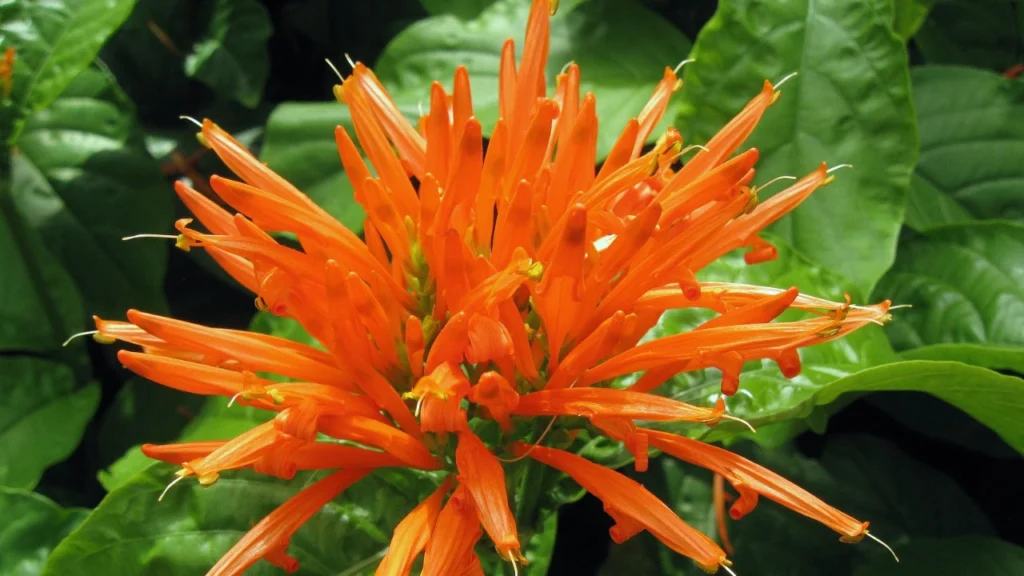The Mexican Honeysuckle (Justicia spicigera), also known as Firecracker Bush, is a species of perennial shrub belonging to the Acanthaceae family. Native to regions extending from Mexico to northwestern Colombia, including the Bahamas and Hispaniola, this plant is valued both for its ornamental qualities and its traditional uses.
The genus name, Justicia, honors James Justice, an 18th-century Scottish horticulturist. The specific epithet, spicigera, derives from Latin and means “spike-bearing,” referring to the plant’s characteristic spike-shaped inflorescences.

Mexican Honeysuckle is found in a variety of environments, including disturbed vegetation areas, deciduous and semi-deciduous tropical forests, evergreen forests, and mixed woodlands. Its adaptability to different environmental conditions contributes to its widespread distribution in its native regions.
This perennial shrub can reach up to 1.5 meters (5 feet) in height. It features densely branched and pubescent stems, with leaves arranged in opposite pairs along the stem. The leaves are bright green, ovate in shape, and have a slightly hairy texture on the surface. Its terminal spike-shaped inflorescences consist of tubular or trumpet-shaped flowers in a vibrant orange hue, measuring approximately 4 centimeters (1.6 inches) in length. These inflorescences emerge at the tips of the branches and are known to attract hummingbirds and butterflies. Fruits are rarely observed in cultivation.

One interesting aspect of Justicia spicigera is its ability to produce natural pigments. When the leaves are boiled, the water turns a deep indigo blue, which explains its traditional use in Mexico for dyeing baskets, handicrafts, and textiles. Additionally, plant extracts contain flavonoids with antioxidant properties, sparking interest in studies for potential applications in the food and pharmaceutical industries.
In landscaping, the Mexican Honeysuckle is prized for its vibrant orange tubular flowers, which bloom year-round in warm climates and during the summer in cooler regions. The plant is frequently used to attract hummingbirds and butterflies, adding life and visual interest to gardens. The cultivar “Sidicaro” features enhanced ornamental traits, with a larger growth habit and denser flower clusters.
Its dense, evergreen foliage with an informal appearance, combined with its ease of cultivation, makes it a popular choice for hedges, borders, and mass plantings. Additionally, the species is adaptable to different light conditions, thriving in both full sun and partial shade, expanding its usability in landscape design.

A plant that adapts well to various growing conditions, the Mexican Honeysuckle prefers environments with direct sunlight or partial shade, ideally in locations receiving four to six hours of sunlight per day. It thrives in warm and humid climates but can also tolerate periods of drought. The ideal soil should be well-draining, fertile, deep, and rich in organic matter, with a slightly acidic to neutral pH.
For optimal growth and abundant flowering, regular watering is essential, especially during hotter periods. The soil should be kept moist but not waterlogged to prevent root rot. Fertilization can be carried out quarterly using organic fertilizers such as well-aged manure or slow-release fertilizers like Osmocote or Basacote, ensuring the plant receives the necessary nutrients for healthy development. Regular pruning is recommended to maintain the desired shape and encourage more prolific flowering. Occasionally, a drastic pruning may be performed to rejuvenate the foliage.

Regarding pests and diseases, Justicia spicigera is generally resistant. However, it may occasionally be affected by insects such as scale insects and aphids. Regular inspection of the plant is essential to detect infestations early. If pests are observed, manual removal or the application of natural solutions such as neem oil is recommended for control.
The species is commonly propagated through stem cuttings. During spring or summer, select healthy stems and cut segments approximately 10 to 15 centimeters (4 to 6 inches) long. Remove the lower leaves and plant the cuttings in a light, well-draining substrate, keeping it moist until rooting occurs, usually within a few weeks. Once rooted, the young plants can be transplanted to their final location in the garden or into larger pots


